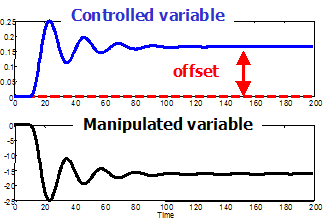|
One constant for each mode. |
|
Apply Your Knowledge |
| 8.7 What are the units of the PID tuning constants? |
PID Algorithm |
| 8.8 If the steady-state process gain (Kp) has a value of zero, the controller gain (Kc) should be... |
PID Algorithm |
| 8.9 Why is the integral time (TI) in the denominator? |
PID Algorithm |
| 8.10 The PID controller... |
PID Algorithm |
| 8.11 Zero steady-state offset is important because... |
PID Algorithm |
| 8.12 What generally limits the "aggressiveness" possible with the PID controller ( why must we observe limits, |KC|< max, TI > min )? |
PID Algorithm |
| 8.13 What is the effect of each mode of the PID controller the on steady-state offset for a step input? |
PID Algorithm |
| 1. | Proportional |  |
||
| 2. | Integral | |||
| 3. | Derivative |
| 8.14 What is the purpose of the initialization constant "I" in the PID algorithm? |
PID Algorithm |